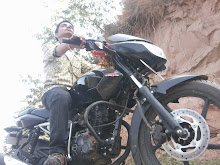
IT is an electric motor that initiates rotational motion in an internal combustion engine before it can power itself.
The modern starter motor is either a permanent-magnet or a series- or series-parallel wound direct current electric motor with a solenoid switch (similar to a relay) mounted on it. When current from the starting battery is applied to the solenoid, usually through a key-operated switch, it pushes out the drive pinion on the starter driveshaft and meshes the pinion with the ring gear on the flywheel of the engine.
The solenoid also closes high-current contacts for the starter motor, which begins to turn. Once the engine starts, the key-operated switch is opened, a spring in the solenoid assembly pulls the pinion gear away from the ring gear, and the starter motor stops. The starter's pinion is clutched to its driveshaft through an overrunning sprag clutch which permits the pinion to transmit drive in only one direction. In this manner, drive is transmitted through the pinion to the flywheel ring gear, but if the pinion remains engaged (as for example because the operator fails to release the key as soon as the engine starts), the pinion will spin independently of its driveshaft. This prevents the engine driving the starter, for such backdrive would cause the starter to spin so fast as to fly apart. However, this sprag clutch arrangement would preclude the use of the starter as a generator if employed in hybrid scheme mentioned above; unless modifications are made.
This overrunning-clutch pinion arrangement was phased into use beginning in the early 1960s; before that time, a Bendix drive was used. The Bendix system places the starter drive pinion on a helically-cut driveshaft. When the starter motor begins turning, the inertia of the drive pinion assembly causes it to ride forward on the helix and thus engage with the ring gear. When the engine starts, backdrive from the ring gear causes the drive pinion to exceed the rotative speed of the starter, at which point the drive pinion is forced back down the helical shaft and thus out of mesh with the ring gear.
An intermediate development between the Bendix drive developed in the 1930s and the overrunning-clutch designs introduced in the 1960s was the Bendix Folo-Thru drive. The standard Bendix drive would disengage from the ring gear as soon as the engine fired, even if it did not continue to run. The Folo-Thru drive contains a latching mechanism and a set of flyweights in the body of the drive unit. When the starter motor begins turning and the drive unit is forced forward on the helical shaft by inertia, it is latched into the engaged position. Only once the drive unit is spun at a speed higher than that attained by the starter motor itself (i.e., it is backdriven by the running engine) will the flyweights pull radially outward, releasing the latch and permitting the overdriven drive unit to be spun out of engagement. In this manner, unwanted starter disengagement is avoided before a successful engine start.


















0 comments:
Post a Comment
It's all about friendly conversation here at Small Review :) I'd love to hear your thoughts!
Be sure to check back again because I do make every effort to reply to your comments here.
Because I am absolutely terrible about following through with blog awards, I can't in good conscience accept any more. Thank you very much for thinking of me though!
Spam WILL be deleted. Attacks on myself or other comments WILL be deleted.